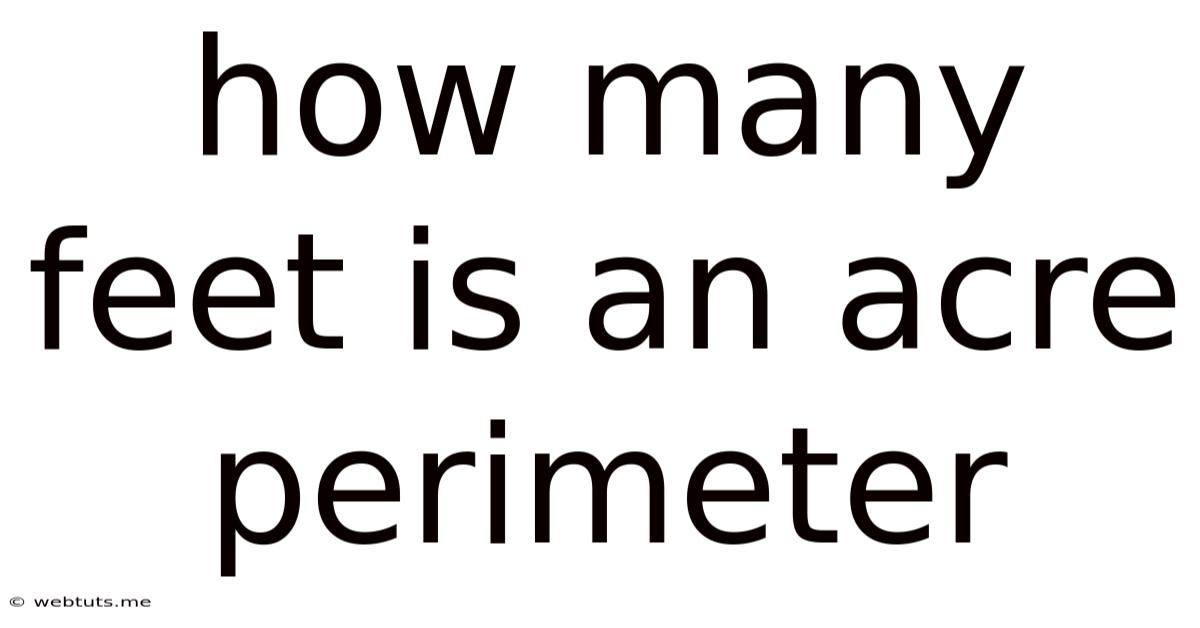How Many Feet Is An Acre Perimeter
Webtuts
May 11, 2025 · 4 min read

Table of Contents
How Many Feet is an Acre Perimeter? Understanding Land Measurement
Determining the perimeter of an acre isn't as straightforward as it might seem. Unlike a square or rectangle with easily calculated sides, an acre's perimeter depends entirely on its shape. An acre is a unit of area, not a unit of length or perimeter. This means that an acre can be a square, a rectangle, a circle, or even an irregular shape, all with vastly different perimeters. This article will delve into the complexities of land measurement, exploring different acre shapes and their corresponding perimeters, offering practical applications, and highlighting the importance of precise land surveying.
Understanding Acres and Perimeters: The Basics
Before we delve into the specifics, let's solidify our understanding of the key terms:
-
Acre: A unit of land area, equal to 43,560 square feet. Think of it as a measurement of the space within a boundary.
-
Perimeter: The total distance around the outside of a shape or area. This is a measurement of the boundary itself.
The crucial point is that an acre doesn't dictate a specific perimeter. A one-acre plot could be long and skinny, short and wide, or any shape in between, each resulting in a different perimeter.
Calculating the Perimeter of Common Acre Shapes
Let's explore the perimeters of some common acre shapes, illustrating how the shape dramatically affects the total perimeter.
The Square Acre
This is the simplest scenario. A square acre has sides of approximately 208.7 feet (√43560 ≈ 208.7). The perimeter is therefore:
4 * 208.7 feet = 834.8 feet
This is the minimum perimeter possible for a one-acre plot. Any other shape will have a longer perimeter.
The Rectangular Acre
Rectangular acres are far more common than square ones. The perimeter calculation is straightforward:
Perimeter = 2 * (Length + Width)
To illustrate, consider a rectangle with a length of 417.4 feet and a width of 104.35 feet (both resulting in an area of 43,560 square feet). The perimeter would be:
2 * (417.4 feet + 104.35 feet) = 1043.5 feet
This demonstrates how a change in shape, while maintaining the same area (one acre), significantly increases the perimeter.
The Circular Acre
A circular acre is less common in practical land use but presents an interesting calculation. The area of a circle is πr², where 'r' is the radius. We know the area is 43,560 square feet, so:
πr² = 43560 r² = 43560/π r ≈ 117.75 feet
The circumference (perimeter) of a circle is 2πr:
2 * π * 117.75 feet ≈ 739.4 feet
This shows that even with a curved shape, the perimeter is still considerably different from the square acre.
The Irregular Acre: A Challenge in Measurement
Many real-world acre plots are irregular, with curves, angles, and varying side lengths. Calculating the perimeter of such a plot is considerably more challenging and typically requires techniques from surveying.
Techniques for Measuring Irregular Acres:
-
Traditional Surveying: This involves using tools like measuring tapes, theodolites (for angles), and possibly GPS to meticulously measure the boundaries of the property. Points are marked along the boundary at regular intervals, and the distances between these points are measured. The perimeter is then calculated by summing these individual distances.
-
GPS Surveying: More modern methods use GPS technology to obtain highly accurate coordinates of points along the boundary. Specialized software can then calculate the perimeter based on these coordinates. This method is often faster and more precise than traditional surveying, especially for larger or more complex properties.
Practical Applications and Importance of Accurate Measurement
Precise land measurement has numerous practical applications:
-
Property Valuation: Accurate acreage and perimeter measurements are crucial for determining the fair market value of a property.
-
Construction and Development: Knowing the exact perimeter is essential for planning construction projects, fencing, landscaping, and infrastructure development.
-
Legal and Boundary Disputes: Accurate measurements help prevent and resolve boundary disputes between neighboring properties.
-
Environmental Studies: Accurate land area measurements are vital for various environmental assessments, including habitat mapping and conservation efforts.
-
Agricultural Planning: Farmers need precise measurements to optimize land use, irrigation, and crop yields.
Conclusion: Beyond Simple Calculations
While the simple calculations for square and rectangular acres provide a starting point, understanding that an acre's perimeter is highly variable based on its shape is crucial. For irregularly shaped plots, professional surveying techniques are essential for obtaining accurate measurements. The perimeter isn't simply a matter of academic interest; it has significant practical implications in various fields, highlighting the importance of precise land measurement and its impact on property valuation, legal boundaries, and effective land management. Remember, an acre is a measure of area, not perimeter, and the shape significantly influences the total length of its boundaries. This understanding is key to navigating the complexities of land ownership and utilization.
Latest Posts
Latest Posts
-
How Many Months Are Left In 2024
May 13, 2025
-
How Many Ml In 21 Oz
May 13, 2025
-
How Many Hours Is 1000 Seconds
May 13, 2025
-
How Many Days Till March 5th 2025
May 13, 2025
-
How Many Grams In One Ton
May 13, 2025
Related Post
Thank you for visiting our website which covers about How Many Feet Is An Acre Perimeter . We hope the information provided has been useful to you. Feel free to contact us if you have any questions or need further assistance. See you next time and don't miss to bookmark.